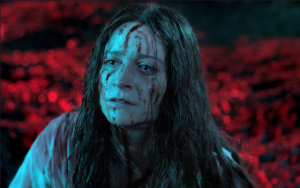CENSOR: 3 STARS. “explores the relationship between art and real-life.”
 In “Censor,” a new psychological horror film on VOD, Niamh Algar plays Enid, a stern young woman who brings childhood trauma to her job as an English film censor.
In “Censor,” a new psychological horror film on VOD, Niamh Algar plays Enid, a stern young woman who brings childhood trauma to her job as an English film censor.
Set in Margaret Thatcher’s Britain, “Censor” makes it clear that Enid sees her job as an essential service. Her profession, as she sees it, is to protect the public by cutting out eye gouges, intestinal tug of wars and other ghastly staples from the “video nasties” she screens before they are released. Convinced those bloody exploitation films feed anti-social behavior, she’s snip happy. Her co-workers mockingly call her “Little Miss Perfect” but she has a dark side.
When she reviews a gorefest called “Don’t Go in the Church,” it brings back long suppressed memories of the disappearance of her sister Nina. Delving deeper into the work of the movie’s notorious director Frederick North, she comes across Alice Lee (Sophia La Porta), an actress who looks exactly like her late sister. Searching for answers Enid visits the set of North’s new film, and her descent into madness begins. “People think I create the horror,” North says. “But I don’t. Horror is already out there, in all of us.”
“Censor” works on several levels. It has elements of the video nasties Enid tries to suppress, but as fact and fiction intertwine, it is her efforts to edit her memories that resonates. She is driven in her work by trauma in her life, and vice versa. As “Censor” drifts from tribute to the video nasties that fuel the early part of the story to a psychological portrait of Enid’s problems, it is clear she can no longer tell what is real and what is not. Driven by guilt, she is unable to move past grief to acceptance. That is the root of her problems, not the outside influence of art, no matter how grotesque.
The Welsh-born director Prano Bailey-Bond doesn’t have quite enough steam to keep the intriguing premise going straight through to the end but she does fill the screen with compelling images, some inspired by the lurid video nasty period VHS horror aesthetic, others reflecting the dull grey of 1980s England. It adds up to a movie that stylishly explores the relationship between art and real-life.
